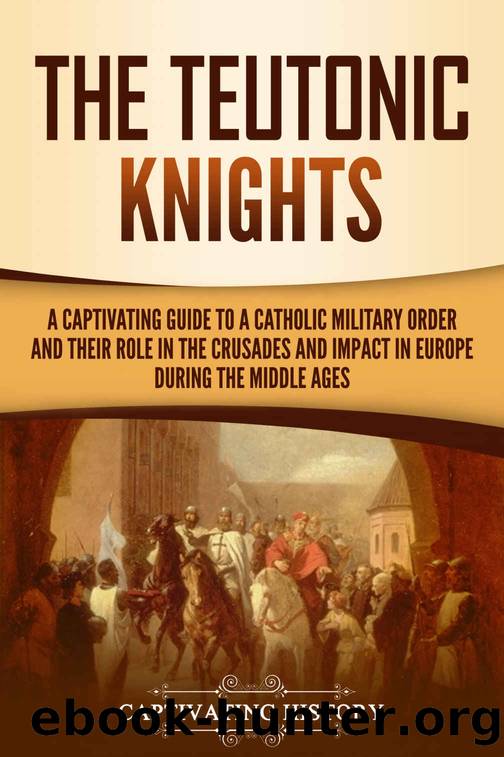The Teutonic Knights: A Captivating Guide to a Catholic Military Order and Their Role in the Crusades and Impact in Europe during the Middle Ages by History Captivating

Author:History, Captivating
Language: eng
Format: epub
Published: 2021-10-18T00:00:00+00:00
Chapter 6 â The Stage is Set
âI entreat masters to live a good life and faithfully to instruct their scholars, especially that they may love God and learn to give themselves to knowledge, in order to promote his honor, the welfare of the state. And their own salvation, but not for the sake of avarice or the praise of man.â
-Jan Hus
Grand Master Küchmeister had ousted Heinrich von Plauen to avoid a conflict, yet by the summer of 1414, a war between the Teutonic Knights and the Polish-Lithuanian Union was more imminent than ever. And now the knights were in an even weaker position than they would have been had Küchmeister allowed Heinrich von Plauenâs plans for war proceed unhindered.
Nevertheless, Küchmeister was now the man in charge, and he had to defend the Teutonic domain accordingly. His first effort to solidify the Teutonic position was to send troops to the province of Culm in order to block the path of incoming Polish-Lithuanian troops.
In July of 1414, the Polish-Lithuanian forces arrived at Osterode, East Prussia. The knightsâ adversaries were ruthless on their march, indiscriminately slaughtering civilians on their way through the surrounding region. It was a dire situation, but Grand Master Küchmeister had taken an important precaution prior to the invasion. He had seized as many foodstuffs as he could and burned the rest, making sure that the invading army would not have the resources to feed themselves once they arrived. This was why this renewed conflict was known as the âHunger War.â
Along with severe hunger, the Polish-Lithuanian troops were also struck with a severe epidemic of dysentery. Despite what looked like an easy advance on the Polish-Lithuaniansâ part, the huge armies were forced to make a tactical withdraw.
This latest outbreak of fighting ended in October of 1414 when direct papal mediation brought about what was essentially a ceasefire between the two belligerents. Terms were hammered out in the city of Strasbourg, which rendered a two-year truce known as the Treaty of Strasbourg. But once again, all this did for the Teutonic Knights was buy them some extra time.
This was time that Grand Master Küchmeister knew must be spent building up his forces before the next assault arrived. Since the ranks of the Teutonic Knights had significantly dwindled, the order was relying more and more upon hired mercenaries for support. These mercenaries had to be paid, and the payment for their services was creating a serious drain on the economy of the Teutonic dominion.
To the great dismay of the clergy, Grand Master Küchmeister gathered up all of the precious metals from the local churches and had them melted down just to be able to mint coins. Even with this influx of silver, he was still only able to mint coins of a debased value due to the limited precious metals available. This was barely enough to be able to keep the hired mercenaries in the employ of the Teutonic Knights. And ultimately, the debased coins put into circulation only helped to damage the prestige of the order since it served as an indication of just how far they had fallen.
Download
This site does not store any files on its server. We only index and link to content provided by other sites. Please contact the content providers to delete copyright contents if any and email us, we'll remove relevant links or contents immediately.
| Administration | Assessment |
| Educational Psychology | Experimental Methods |
| History | Language Experience Approach |
| Philosophy & Social Aspects | Reform & Policy |
| Research |
The Art of Coaching Workbook by Elena Aguilar(48572)
Trainspotting by Irvine Welsh(20140)
Twilight of the Idols With the Antichrist and Ecce Homo by Friedrich Nietzsche(17754)
Fangirl by Rainbow Rowell(7893)
Periodization Training for Sports by Tudor Bompa(7376)
Change Your Questions, Change Your Life by Marilee Adams(6702)
This Is How You Lose Her by Junot Diaz(5845)
Grit by Angela Duckworth(4778)
Red Sparrow by Jason Matthews(4734)
Asking the Right Questions: A Guide to Critical Thinking by M. Neil Browne & Stuart M. Keeley(4642)
Paper Towns by Green John(4209)
Room 212 by Kate Stewart(4152)
Ken Follett - World without end by Ken Follett(4003)
The Sports Rules Book by Human Kinetics(3630)
Housekeeping by Marilynne Robinson(3456)
The Motorcycle Diaries by Ernesto Che Guevara(3380)
Introduction to Kinesiology by Shirl J. Hoffman(3329)
Exercise Technique Manual for Resistance Training by National Strength & Conditioning Association(3329)
Papillon (English) by Henri Charrière(3324)
